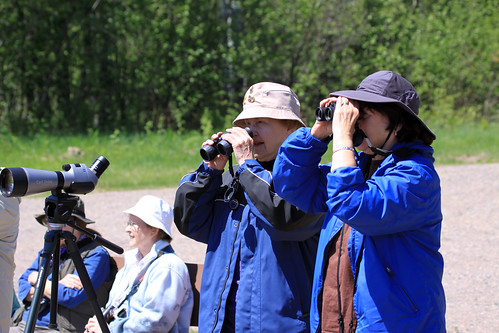 |
| Camaraderie and sharing spotting scopes are big attractions to birding with friends. We can get back to these joys soon enough. |
Some birders have expressed outrage that their favorite birding spots are closed, and some have even boasted about parking and getting around or under entrance gates on foot. But very few people have the knowledge and carry the supplies to deal with their waste hygienically under normal conditions, much less when we’re in the middle of a health emergency. Imagine being the employees who will return after weeks or months, to clean up after scofflaws. When our favorite birding spots are closed, we need to make the best of it.
Dr. Peter Crosson, a birder and a medical doctor, wrote an extremely valuable post to a Massachusetts birding listserv, and he’s generously given me permission to quote it. He wrote:
In my non-birding day job I'm a physician, bracing for the ramping up of COVID cases and the horrifying specter of lives lost to this disease.
It's become abundantly clear that this is a disease that needs to be beaten on the public health front, not at the bedside. As a member of a wonderful, vibrant birding community, with many birders "of a certain age," I feel the need to speak up a bit about our responsibilities to each other and to the country as a whole.
As we've all heard, social distancing is key, and birding can be a wonderful form of social distancing. However, it's not social distancing when you are riding in the car with other birders who don't live with you. It's not social distancing when you are clustering in groups, and certainly not when you are sharing optics such as scopes.
Anyone of us can be exposed to the virus through asymptomatic friends, so to restrict yourself to hanging out with people who have no symptoms is not enough. Since this began, I have gone birding once with another person. We met at the site, having come in separate cars. We kept 6 feet distance between us at all times, and did not share any optics. If you are not following procedures like that, you're not social distancing. It's also obviously important at more popular sites to avoid touching handrails that other people could be touching, as the virus can live on surfaces for up to three to five days. Frequent handwashing and use of at least 60% alcohol-based hand sanitizer is also crucial.
It discourages me when I look on eBird and see multiple people reporting the same group checklist from a site. Maybe I am wrong, and they are all arriving in separate cars and keeping distance between themselves, but I doubt that's the case. We are at a tipping point in this crisis, and as an educated and caring group we need to commit to doing everything we can to stop COVID-19. If we lose one member of our birding community because of this virus, it will be a tragedy. Make no mistake, if we do not change our behavior, that is near certain.
Dr. Peter CrossonIt’s so hard to be dealing with this sudden massive disruption in our daily lives. Those of us who love birding are of course disappointed to be cutting back our activities right during the most thrilling time of year—spring migration, when we see so many wonderful birds when we can visit lots of habitat. Backyard birding may not be anywhere near as thrilling, but this is a time to appreciate tiny joys as we can. And building up a yard list has plenty of joys of its own. The more seriously we take social distancing now, the more of us will be able to get back into our favorite old birding practices next spring.
